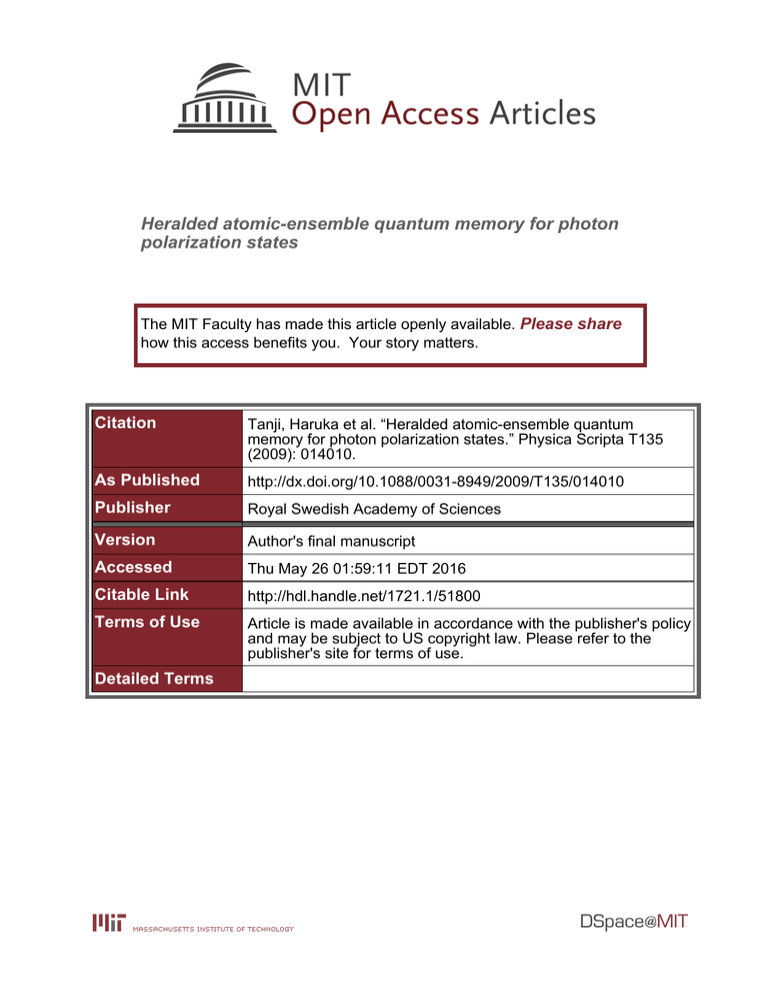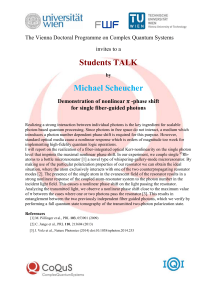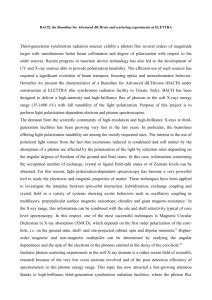Heralded atomic-ensemble quantum memory for photon polarization states Please share
advertisement

Heralded atomic-ensemble quantum memory for photon polarization states The MIT Faculty has made this article openly available. Please share how this access benefits you. Your story matters. Citation Tanji, Haruka et al. “Heralded atomic-ensemble quantum memory for photon polarization states.” Physica Scripta T135 (2009): 014010. As Published http://dx.doi.org/10.1088/0031-8949/2009/T135/014010 Publisher Royal Swedish Academy of Sciences Version Author's final manuscript Accessed Thu May 26 01:59:11 EDT 2016 Citable Link http://hdl.handle.net/1721.1/51800 Terms of Use Article is made available in accordance with the publisher's policy and may be subject to US copyright law. Please refer to the publisher's site for terms of use. Detailed Terms Heralded atomic-ensemble quantum memory for photon polarization states Haruka Tanji1,2 , Jonathan Simon1,2 , Saikat Ghosh2 and Vladan Vuletić2 1 Department of Physics, Harvard University, Cambridge, Massachusetts 02138, USA Department of Physics, MIT-Harvard Center for Ultracold Atoms, and Research Laboratory of Electronics, Massachusetts Institute of Technology, Cambridge, Massachusetts 02139, USA 2 E-mail: vuletic@mit.edu Abstract. We describe the mapping of quantum states between single photons and an atomic ensemble. In particular, we demonstrate a heralded quantum memory based on mapping of a photon polarization state onto a single collective-spin excitation (magnon) shared between two atomic ensembles. The polarization fidelity above 90(2)% for any input polarization far exceeds the classical limit of 23 . The process also constitutes a quantum non-destructive probe that detects and regenerates a photon without measuring its polarization. PACS numbers: 03.67.Hk, 32.80.Pj, 42.50.Dv 1. Introduction: Coherent mapping between single photons and single magnons A quantum memory, i.e., a system that can receive and store quantum states that are ideally carried by photons, is a key element for quantum information processing [1, 2, 3, 4, 5, 6, 7, 8, 9]. The conceptually simplest quantum memory is a single twolevel atom. Coherent mapping between a photon and the atom acting as a quantum memory requires the atom to appear opaque to the photon. This can be achieved by focusing the photon to a small area containing the atom, and passing it through this surface many times using mirrors with very low loss [10]. In the optical regime an opacity (or resonant optical depth η) of η ∼ 100 can be achieved in this way [10]. An alternative method to increase the optical depth is to use an ensemble [1, 2, 3, 4, 5, 11], rather than a single particle. It may seem that an ensemble of non-interacting two-level particles cannot be used as a memory for a quantum bit, as the Hilbert space of the ensemble is much larger than that of the photon, and most ensemble states do not couple strongly to the photon [12]. However, using a probabilistic but heralded process [1], it is possible to restrict the ensemble quantum system to just Heralded atomic-ensemble quantum memory for photon polarization states 2 Figure 1. (a) Set-up for phase-coherent optical transfer of a single spin-wave quantum (magnon) between two ensembles and entanglement generation. Two ensembles, A and B, are defined within a cloud of laser-cooled cesium atoms by two laser beams. A single magnon generated in ensemble A by the detection of a single photon is transferred via a dark state of the resonator to ensemble B. (b) Adiabatic transfer in a five-level system. The magnon can be transferred between two ensembles by time-dependent control of the laser beams ΩA , ΩB addressing the two ensembles. (c) Verification of coherence between the two ensembles. When a single magnon is shared between the two ensembles, the emission into the optical resonator exhibits an interference fringe, in analogy to superradiant and subradiant emission states of two atoms [12]. two states where the atoms couple cooperatively and strongly to the light field [12]. In this way it is possible to generate a single photon from a single quantized spin-wave excitation of the ensemble (magnon) with a probability approaching 90% [11]. 2. Optical transfer of single magnon between two atomic ensembles If two ensembles are located inside an optical resonator, it is possible to transfer a single spin wave quantum between them via the optical resonator while populating the resonator mode only virtually [13]. The method is akin to stimulated adiabatic rapid passage in a five-level system (see Fig. 1b), where the system is transferred from the initial quantum state (|GA i, magnon in ensemble A) to the final state (|GB i, magnon in ensemble B) through three unstable intermediate states (|EA i,|EA i, corresponding to an Heralded atomic-ensemble quantum memory for photon polarization states 3 excited atom in ensembles A and B, respectively, and |Ci, corresponding to a photon in the resonator). In the ideal limit of large optical depth the unstable intermediate states are are only virtually populated, and the magnon transfer from A to B can approach unity, in spite of resonator loss. The transfer from A to B is accomplished by turning on laser beam ΩB , ramping up beam ΩA , and subsequently ramping down ΩB (see Fig. 1a). If the transfer is interrupted when the magnon is found with equal probability in either of the two ensembles (ΩA = ΩB ), the system is left in an entangled state |GA i + eiφ |GB i = |1iA |0iB + eiφ |0iA |1iB , where |niS denoted n magnons in ensemble S = A, B. The existence of a definite quantum phase φ between the components |1iA |0iB and |0iA |1iB can be tested by coupling both ensembles simultaneously to the resonator in an attempt to convert the magnon into a photon that can be directly measured. As the phase φ between the ensembles is varied, the emission into the resonator exhibits interference fringes (Fig. 1c) that can be understood as constructive and destructive interference (superradiance and subradiance) between the emission processes by the two ensembles. In combination with the sub-Poissonian character of the stored single excitations, this interference implies entanglement between the two ensembles [13]. 3. Heralded storage of photon polarization states The coupling of two quantum memories by an optical transmission line will in practice be loss, be it due to optical losses, or to imperfect mapping between the photon and the quantum memory. To a certain extent, such loss can be remedied by a heralding feature where successful storage is announced without giving away the incoming quantum state (Fig. 2b). In the case discussed here, a single photon of fixed polarization announces the successful storage of a photon of unknown, or even potentially undetermined, polarization. Such heralded storage is achieved by means of a spontaneous Raman process that simultaneously creates a photon of fixed polarization that serves as the herald, and a magnon that is a copy of the input-beam polarization (Fig. 2c). To store an arbitrary polarization state |ψi = cos θ |Ri + eiφ sin θ |Li, written as a superposition of right/left circularly polarized states |Ri, |Li with two arbitrary angles θ, φ, we use two spatially overlapped atomic ensembles A, B inside an optical resonator. The atomic levels are chosen such that ensemble A (B) absorbs only |Ri (|Li) polarized light, while both can emit a photon of the same polarization (π) into the resonator on the Raman transition of interest (Fig. 2b). The detection of the emitted π photon heralds the mapping of the input polarization state onto a magnon, but does not provide “which-path” information to distinguish between A and B. The heralding also ensures that, even if the input is a coherent beam, only one magnon is generated between the two ensembles in the limit of small Raman scattering probability. The “write” process thus projects a polarization state |ψi onto a magnon superposition state |ψi → |Ψi = cos θ |1iA |0iB + eiφ sin θ |0iA |1iB . At a later time, the stored state can be retrieved on demand as a single photon by utilizing the strong coupling of the Heralded atomic-ensemble quantum memory for photon polarization states 4 Figure 2. (a) Setup. The storage of a photon of arbitrary polarization from the write beam is heralded by a photon detected on single-photon counter D1. Small arrows indicate beam polarization, OP is the optical pumping beam. NPBS, PBS, QWP, and HWP denote a non-polarizing beamsplitter, a polarizing beamsplitter, a quarterwaveplate, and a half waveplate, respectively. D2, D3 are single-photon counting modules used for polarization analysis of the stored photon. A static magnetic field produces magnon precession. (b) Principle of heralded polarization storage. A heralding photon of fixed polarization announces the storage of a photon of unknown, and potentially undetermined, polarization. (c) Energy levels. Ensembles A and B are initially prepared in hyperfine and magnetic sublevels |g∓ i ≡ |F = 3, mF = ∓3i. The write (green) and the read (red) processes are σ ± -π and π-σ ± spontaneous Raman transitions, respectively. (d) Quantum state tomography of the stored photon. Measured density matrix elements for different photon polarization states. magnon to the resonator mode [1, 11]. The heralded storage occurs rarely (p ∼ 10−6 in our non-optimized setup), but when it does, the incident photon is stored and can later be recreated with good efficiency (ε ∼ 50%) and sub-Poissonian statistics (g2 ≈ 0.24), while its polarization state is restored with very high fidelity (F > 90%). The fidelity of the stored state is measured by converting the stored magnon into a photon, and performing quantum state tomography. Fig. 2d shows the reconstructed density matrix for three different input polarizations. It should be possible to significantly increase the storage probability to a few percent by increasing the resonator finesse from the current low value F ∼ 300 to F ∼ 104 . Then it would be possible to use the current system for the storage of incoming single photons or entangled photon pairs, as, e.g., produced by a parametric downconverter. The storage of such pairs would then enable the heralded or deterministic generation of Heralded atomic-ensemble quantum memory for photon polarization states 5 entangled photon pairs. Acknowledgments We gratefully acknowledge support by the NSF and DARPA. J.S. thanks the NDSEG and NSF for support. References [1] L.-M. Duan, M. D. Lukin, J. I. Cirac, and P. Zoller. Generation of nonclassical photon pairs for scalable quantum communication with atomic ensembles. Nature, 414:413, 2001. [2] C. W. Chou, S. V. Polyakov, A. Kuzmich, and H. J. Kimble. Single-photon generation from stored excitation in an atomic ensemble. Phys. Rev. Lett., 92:213601, 2004. [3] D. Matsukevich and A. Kuzmich. Quantum state transfer between matter and light. Science, 306:663, 2004. [4] T. Chaneliere, D. N. Matsukevich, S. D. Jenkins, S. Y. Lan, T. A. B. Kennedy, and A. Kuzmich. Storage and retrieval of single photons transmitted between remote quantum memories. Nature, 438:833, 2005. [5] M. D. Eisaman, A. André, F. Massou, M. Fleischhauer, A. S. Zibrov, and M. D. Lukin. Electromagnetically induced transparency with tunable single-photon pulses. Nature, 438:837, 2005. [6] Brian Julsgaard, Jacob Sherson, J. Ignacio Cirac, Jarom.Fiurášek, and Eugene S. Polzik. Experimental demonstration of quantum memory for light. Nature (London), 432:482, 2004. [7] K.S. Choi, H. Deng, J. Laurat, and H.J. Kimble. Mapping photonic entanglement into and out of a quantum memory. Nature, 452:67 – 71, 2008. [8] Kazuhito Honda, Daisuke Akamatsu, Manabu Arikawa, Yoshihiko Yokoi, Keiichirou Akiba, Satoshi Nagatsuka, Takahito Tanimura, Akira Furusawa, and Mikio Kozuma. Storage and retrieval of a squeezed vacuum. Phys. Rev. Lett., 100:093601, 2008. [9] Jürgen Appel, Eden Figueroa, Dmitry Korystov, M. Lobino, and A. I. Lvovsky. Quantum memory for squeezed light. Phys. Rev. Lett., 100:093602, 2008. [10] J. McKeever, A. Boca, A.D. Boozer, R. Miller, J.R. Buck, A. Kuzmich, and H.J. Kimble. Deterministic generation of single photons from one atom trapped in a cavity. Science, 303:1992, 2004. [11] Jonathan Simon, Haruka Tanji, James K. Thompson, and Vladan Vuletić. Interfacing collective atomic excitations and single photons. Phys. Rev. Lett., 98:183601, 2007. [12] R. H. Dicke. Coherence in spontaneous radiation processes. Phys. Rev., 93:99, 1954. [13] Jonathan Simon, Haruka Tanji, Saikat Ghosh, and Vladan Vuletić. Single-photon bus connecting spin-wave quantum memories. Nature Physics, 3:765, 2007.







